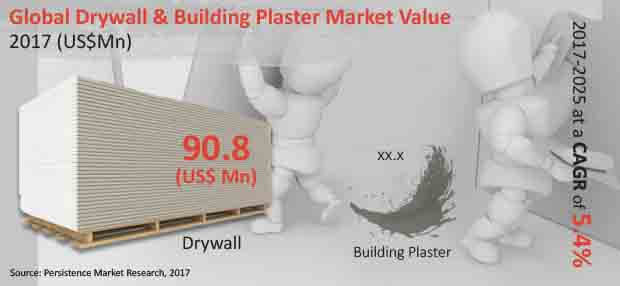Drywall & Building Plaster Market Segmented By Drywall, Building Plaster Product in Residential, Wholesale and Retail Buildings, Offices, Academic and Educational Buildings, Hotels and Restaurants
Industry: Chemicals and Materials
Published Date: June-2017
Format: PPT*, PDF, EXCEL
Delivery Timelines: Contact Sales
Number of Pages: 218
Report ID: PMRREP3360
Drywall has been found to adhere to certain specific construction requirements in hotels and shopping complexes as a lightweight construction material that is also fire-resistant. Recently, hotels, restaurants, and educational institutes that seek to have a soundproof facility have looked to the drywall and building plaster market.
In residential properties, drywalls are thought to be critical in simultaneously improving the aesthetic appeal and managing interior heat through thermal insulation provided by false ceilings. Drywalls have also seen increased demand because of their flexibility in dividing and creating spaces, thus enabling quick and seamless interior customization options.
There are certain inherent disadvantages in using drywall. Drywall is somewhat delicate and carries a risk of being damaged. In addition, drywall needs skilled manpower for installation and this increases the fixed cost. Couple this with the fact that drywall mud sanding is an unwanted procedural step because of the fine dust generated and it is not hard to understand why drywalls are becoming less popular.
Humidity can impact drywalls substantially by causing the growth of fungi that can be a health hazard. There are limitations to the temporary re-fixing and removal of drywall for interior repairs such as plumbing work. Thus, alternatives that are more beneficial are increasingly being sought out. For e.g. Wahoo walls are easy to install, reducing the initial cost and they also have greater heat resistance because of a particular material thickness.
Textured wall panels can be easily fitted over existing walls as they are aesthetically superior when compared to drywalls. Real wood veneer paneling also looks better appearance wise than drywall and the accessories available permit easy installation of the former.
Drywall has immense utility in fire resistance, sound reduction, and in increasing the life of both non-residential and residential civil structures. Drywalls are being utilized as an area separation wall to separate two building units. These factors are anticipated to boost the drywall and building plaster market over the forecast period.

Latin America is shaping up to be a region of immense strategic importance, with Brazil in particular spearheading the economic growth of this dynamic region. The Brazil plasterboard market is showing rapid growth, with twice that shown by the regional construction industry. It has been seen that the Brazil gypsum drywall market has grown at a noticeably high rate. Similarly, construction activities in Argentina, Chile, Mexico, and Peru have contributed to the growth of the Latin America drywall and building plasters market.
Thus, major players in the global drywall and building plaster market have targeted the region by way of establishing new Greenfield units that also increase their sales and distribution network in these key strategic countries. Global majors such as Saint-Gobain, Etex, and Knauf have set up gypsum and plasterboard manufacturing units in Brazil recently and they have also collaborated with local distributors and suppliers to increase their sales volumes.
Brazil is the largest economy in South & Latin America and it dominates the Latin America drywall and building plaster market. The country accounts for approximately half the Latin America drywall and building plaster market by itself and this is poised to rise to 52% by the end of 2025. Brazil should register a massive 200 BPS growth, while Mexico and the rest of Latin America should decline by 30 and 170 BPS respectively.
Gypsum is predicted to have strong demand in the Latin America market and gain 130 BPS over the duration of the forecast period. The Gypsum segment by product type is anticipated to account for roughly 34% of the Latin America building plaster market in 2017 with a value of a little over US$ 350 Mn.
The highest CAGR by value in the product type category is anticipated to be recorded by the Gypsum segment (5.7%), making it the perfect segment for key stakeholders to target in the Latin America building plaster market.
| Attribute | Details |
|---|---|
|
Product Type |
|
|
Application |
|
|
Region |
|
To know more about delivery timeline for this report Contact Sales